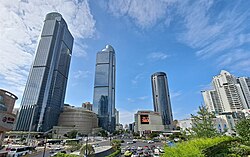Xuhui
徐汇区 | |
|---|---|
 Xujiahui Business District | |
 | |
 Xuhui in Shanghai | |
| Country | People's Republic of China |
| Municipality | Shanghai |
| Government | |
| • Body | Xihui District People's Congress |
| Area | |
| • Total | 54.76 km2 (21.14 sq mi) |
| Population (2020) | |
| • Total | 1,113,078 |
| • Density | 20,000/km2 (53,000/sq mi) |
| Time zone | UTC+8 (China Standard) |
| Xuhui, Shanghai | |||||||||||
|---|---|---|---|---|---|---|---|---|---|---|---|
| Simplified Chinese | 徐汇区 | ||||||||||
| Traditional Chinese | 徐匯區 | ||||||||||
| Postal | Siccawe | ||||||||||
| |||||||||||
Xuhui District is a core urban district of Shanghai. It has a land area of 54.76 km2 (21.14 sq mi) and a population of 1,113,078 as of 2020.[1][2] Xuhui District has 12 subdistricts and two townships.
The Xuhui District is named after its namesake, the historic area of Xujiahui. Xujiahui was historically land owned by Ming dynasty bureaucrat and scientist Xu Guangqi, and later donated to the Roman Catholic Church. It and Luwan District jointly formed the core of Catholic Shanghai, centered in the former French Concession of Shanghai. Vestiges of the French influence can still be seen in the St. Ignatius Cathedral of Shanghai, Xuhui College, the Xujiahui Observatory, and some remaining boulevards and French-style districts.
Xujiahui itself has been redeveloped as a financial center, with a proliferation of large-scale shopping centers and department stores, and is now a major shopping destination in the city with shopping malls such as Grand Gateway Shanghai and Pacific Sogo.
- ^ "China: Shànghăi (Districts) - Population Statistics, Charts and Map". www.citypopulation.de. Retrieved 2024-02-09.
- ^ "Population and Employment". shanghai.gov.cn. Shanghai Municipal People's Government. Retrieved 31 July 2011.